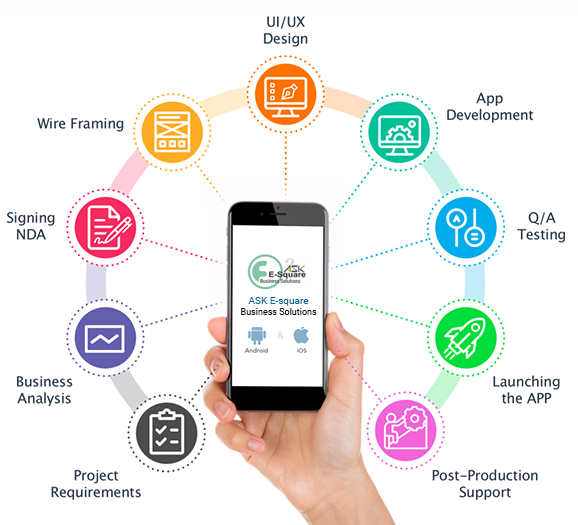The process of developing software applications especially for mobile platforms, such tablets and smartphones, is known as mobile app development. An outline of the essential elements and procedures in mobile app development is provided below:
Conceptualization and Planning: Specify the objectives, target market, and purpose of the mobile application. To ascertain consumer wants and preferences, evaluate rivals, and assess the viability of the app idea, conduct market research. Make a thorough development process strategy and roadmap that includes features, functionalities, and deadlines.
Platform Selection: Decide which platform (or platforms) to create the app for. Examples of these include iOS, Android, and cross-platform development frameworks like Flutter or React Native. Take into account elements like the target audience’s demographics, the market share of devices, and the available development resources.


UI/UX Design: Create an intuitive, aesthetically pleasing, and simple-to-use user interface (UI) and user experience (UX) for the application. To see the design, functionality, and user interface of the app, create wireframes and mockups. To provide a smooth user experience, pay attention to branding, typography, color scheme, and accessibility.
Development: Create the features and functionalities of the app in accordance with the technical requirements and design guidelines. Use programming languages and frameworks that are appropriate for the platform(s) you have selected to write your code. Examples of these include Java or Kotlin for Android, Swift or Objective-C for iOS, and JavaScript for cross-platform development.
Backend Development: Create the server-side and backend infrastructure needed to enable the operation of the app, including data storage, user authentication, and server connection, if necessary. Make use of cloud-based services like Firebase or AWS, or technologies like Python, Ruby on Rails, and Node.js.
Integration: To utilize extra features like social media login, payment processing, mapping and geolocation, push notifications, and analytics, integrate third-party services and APIs (Application Programming Interfaces) into the program.
Testing: Conduct a comprehensive test of the app to find and address any bugs, mistakes, or usability problems. To make sure the app functions as intended, conduct functional, usability, compatibility, and performance testing on a range of devices and operating system versions.


Deployment: Prepare the application for release on the relevant app marketplaces (Google Play Store for Android apps, and the Apple App Store for iOS apps). Observe each platform’s rules and specifications, including those regarding app store submission, app information, screenshots, and app store optimization (ASO) techniques.
Launch: Make the app available for download in app stores so that everyone can use it. To reach the target population and gain the app’s first users, promote it using marketing and advertising channels.
Upkeep and Updates: Keep a constant eye on the app’s functionality, user reviews, and analytics information. Gather user opinions and ideas to determine what needs to be improved and what should be added. Over time, provide patches and updates to fix bugs, add new features, and improve the functionality of the program.
